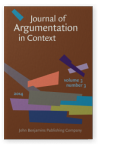Vol. 3:3 (2014) ► pp.231–258
Learning to argue like an expert
The role of topoi in internal medicine residency
Many scholars have argued that practicing medicine requires sophisticated rhetorical prowess (Loftus 2012; Pender 2005; Segal 2005, 2007). Although rhetorical theory can explain how novices learn to argue like experts, much work in the subfield of medical learning only implicitly draws on rhetorical notions (e.g., Barton & Eggly 2009; Heritage & Maynard 2006). This study examines conversations between faculty physician preceptors and resident physician trainees in an internal medicine clinic to consider the role of persuasion in teaching novices to argue like experts. Using Aristotelian topoi, I reveal how the common lines of argument underlying medical teaching and learning help novice and expert physicians explain concepts, elicit interpretations, and initiate deliberation. As they synthesize and rationalize medical information, they use antecedent-and-consequence, possible-and-impossible, authority, and testimonial topoi. This study of professional enculturation elucidates a rarely examined area of medical communication, potentially enabling preceptors to teach their tacit reasoning more explicitly to residents.
